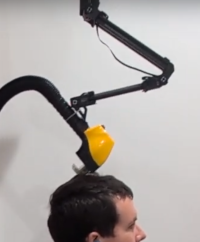Robot Barber
Updated: September 17, 2025

I built a hair cutting robot. Here is a video of my first time using it (February 2, 2025):
The first haircut wasn't great because it only used a single length setting. Since then, I have upgraded it with three length settings:
- longest setting: all regions
- medium setting: sides and back
- shortest setting: around ears and neck. I use my hand to fold my ear so that the trimmer can get close.
The full haircut takes about 15 minutes (this video is at 5x speed):
I am really happy with the results. Since February 2025 I have only been using this robot to cut my hair. Compared to a human barber, it has some nice advantages:
- consistency: every haircut is exactly the same, in the style that I like
- cost: ignoring the initial cost of materials (details below), the only cost is electricity
- time: getting the haircut at home is significantly faster than going to a barber
- clean: 100% of hair gets sucked up by the vacuum. At a barber I always end up with leftover hair trimmings stuck to my head.
Cost
All of the main components are available off-the-shelf:
- robot arm: $223.99 Waveshare Roarm-M2-S
- vacuum trimmer: $199.96 Flowbee Haircutting System
- 5 HP vacuum: $67.99 Vacmaster 6-Gallon Wet/Dry Vacuum
- electric standing desk: $95.19 DUMOS 40 x 24 inch
That comes to a total of $587.13. Here is a list of some additional low-cost parts:
- plastic table (placed on top of standing desk)
- wooden board (place on top of plastic table)
- chair
- old laptop
Software
I used Python to write the robot control program. It runs on a laptop and connects to the arm via wifi. The program uses a preset path without any sensor feedback.
The way I created the control path was by manually positioning the arm and recording the servo positions. I used a styrofoam head to position the arm. Here is an example waypoint:
{"T":122,"b":3,"s":-1.42,"e":2,"h":1.5,"spd":10,"acc":10}
I have released the software on GitHub here.
Commercialization
While the robot has been working great for my own usage, there would be challenges in commercializing it. The two primary options would be:
- Installing the robots in barbershops for shared usage
- Selling directly to customers for home usage
Challenges for either of these use-cases:
- The software is hard-coded specifically for my head size and style preference. Generalizing to a larger range of head sizes and hair styles would be challenging (but solvable). Certain hair types and styles would not work.
- I think the robot is already pretty safe, but to make it into a commercial product it would need additional safety considerations. For example, if there is a power outage, the arm would suddenly lower onto the user's head/shoulder, which could cause a minor injury.
Challenges for barbershop usage:
- The vacuum is really loud. It needs to be powerful to reliably suck hair. It is fine when wearing earplugs, but in a barbershop it would disturb everyone nearby.
- Besides "consistency", human barbers can still outperform the robot in many ways. The robot might not support the exact style that you want, while human barbers are more flexible (e.g. you can give feedback throughout the haircut).
- In a barbershop, there would likely still need to be staff to operate the robot and interact with customers. Since staff are still needed, it doesn't save much cost to have the robot.
Selling the robot for home usage might be more promising, but it still has issues:
- To make it into a profitable product, the consumer price would need to be high. Probably not many people would want to spend ~$1000 for such a system. The product (desk+chair) also takes up significant floor space.
- The user experience is complicated: how to assemble the product, how to operate the robot, and what to do during the haircut (e.g. in the video above you can see I fold back my ear at a specific time).
Contact
Let me know (email: byron@byronknoll.com) if you have any thoughts about commercial usage, or if you are interested in constructing one for yourself. I can share instructions. Since it has been working so well for my own usage, I am hoping that someone else could also benefit.
